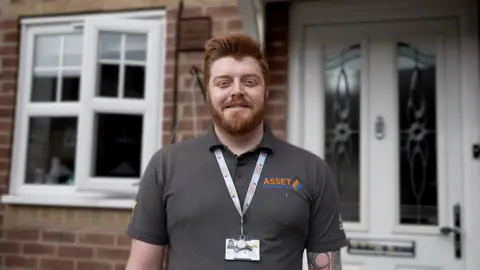AI Research
Planning change makes heat pump installations easier for homes

Climate and science correspondent
 Getty Images
Getty ImagesA key planning restriction that heat pumps need to be one metre from a neighbour’s property has been lifted as the government seeks to accelerate the take up of the low-carbon technology.
The change, which is part of the government’s Warm Homes Plan to lower household bills and cut planet warming emissions, means it could be easier for millions of homes in England to have a heat pump installed.
But consumer groups warn that the changes will not help those in rented or leasehold properties and the biggest barrier to installing a heat pump remains the high upfront costs.
This is a particular problem for older housing stock where upgrades to pipework and insulation may also be required.
Most UK homes use gas boilers for their hot water and heating, but this produces up to 14% of the country’s planet warming greenhouse gases.
In comparison, heat pumps use electricity, so as the country moves to generating more electricity from renewable energy sources like solar and wind, they could produce far fewer emissions than boilers.
But switching from a gas boiler to a heat pump is expensive and not straightforward if you live in one of England’s six million terraced homes.
Until Thursday, homeowners needed planning permission if they wanted to put a heat pump within one metre of their neighbour’s property – because of concerns over noise.
Tom Clarke, a gas engineer who recently retrained to fit heat pumps, said having to apply for planning permission had been a barrier for his customers.
“When you look across London we have loads and loads of terraced houses and no matter where you site the appliance it is always going to be within one metre of the boundary,” he said.
It was particularly problematic for people replacing a broken gas boiler because many customers would not want to go more than a month without heating waiting for council approval, he said.
This is echoed by Octopus Energy, who told parliament’s Energy Security and Net Zero (ESNZ) Committee in 2023 that this planning rule was affecting 27% of its customers.
“Those who try to proceed end up waiting an additional eight to 10 weeks on average. Even if customers meet all the requirements, there is no guarantee that local councils will grant the permission, as they all have different interpretations of central planning guidelines,” the company wrote in its submission. “The combined impact of all these things mean that very few of the 27% of customers who require planning have made it to install.”
The rule has now been dropped to accelerate the uptake of heat pumps. Previous concerns over noise are less of an issue with newer devices, though units will still be required to be below a certain volume level.
The planning changes also include a relaxation of the rules for the size and number of heat pumps households can install.
Households most likely to be affected are those living in terraced housing. In 2021, they accounted for 5.7 million households, or 23% of the total. Some of these will still need planning permission, for example those living in conservation areas.
 Kevin Church/BBC
Kevin Church/BBCThe change is part of the government’s Warm Homes Plan which aims to give 300,000 households upgrades to improve their energy efficiency and lower bills.
Although the heat pump industry welcomed the changes, many point out the main barrier for many customers is that installing heat pumps is expensive, particularly in older houses, where better insulation may also be needed.
This was the case at social housing estate Sutton Dwellings in Chelsea, London, which underwent a full refurbishment of its fabric alongside a new ground source heat pump network.
Its landlord, Clarion Housing Group, did receive a grant from the government to install the new network but also invested its own money.
Stuart Gadsden, commercial director at Kensa, the company which designed and installed the system, said this was an issue for many landlords: “A big [barrier] is funding, this obviously does cost more to install than a traditional gas boiler system.
“In the social housing sector we have funding from the warm homes social housing fund, but it was oversubscribed by double. Lots of housing associations want to put low carbon heating in but there is not enough to go around.”
 Kevin Church/BBC
Kevin Church/BBCRenters have to rely on landlords being willing to make the initial upfront investment.
Rob Lane, Chief Property Officer at Clarion, said the company was happy to do this at Sutton Dwellings because of the impact for residents: “We’re waiting to see how the costs of running this system bear out, but our forecasts suggests that each home is going to cost on average £450 – £500 per home (each year) – considerable savings for residents.”
From 2030, as part of the Warm Homes plan, there will be mandatory requirements for all private landlords to upgrade the energy efficiency of their properties.
But the way that Energy Performance Certificates (EPC) are currently calculated means a gas boiler can sometimes have a better rating than a heat pump because it looks at energy costs and assumes gas is cheaper.
Katy King, deputy director of sustainability at charity Nesta, said the government could bring down electricity costs.
“The UK has some of the most expensive electricity prices in Europe. The government could take levies off electricity and put them onto gas or use general taxation. It is a tricky choice and one we do expect them to be consulting on within the year,” she said.
A spokesperson from the Department of Energy Security and Net Zero said: “We are supporting industry to develop financing models that can remove the upfront cost entirely, and consulting on new approaches, such as heat pump subscriptions, to help more households make the switch to cleaner heating in a way that works for them.”

AI Research
Measuring Machine Intelligence Using Turing Test 2.0

In 1950, British mathematician Alan Turing (1912–1954) proposed a simple way to test artificial intelligence. His idea, known as the Turing Test, was to see if a computer could carry on a text-based conversation so well that a human judge could not reliably tell it apart from another human. If the computer could “fool” the judge, Turing argued, it should be considered intelligent.
For decades, Turing’s test shaped public understanding of AI. Yet as technology has advanced, many researchers have asked whether imitating human conversation really proves intelligence — or whether it only shows that machines can mimic certain human behaviors. Large language models like ChatGPT can already hold convincing conversations. But does that mean they understand what they are saying?
In a Mind Matters podcast interview, Dr. Georgios Mappouras tells host Robert J. Marks that the answer is no. In a recent paper, The General Intelligence Threshold, Mappouras introduces what he calls Turing Test 2.0. This updated approach sets a higher bar for intelligence than simply chatting like a human. It asks whether machines can go beyond imitation to produce new knowledge.
From information to knowledge
At the heart of Mappouras’s proposal is a distinction between two kinds of information, non-functional vs. functional:
- Non-functional information is raw data or observations that don’t lead to new insights by themselves. One example would be noticing that an apple falls from a tree.
- Functional information is knowledge that can be applied to achieve something new. When Isaac Newton connected the falling apple to the force of gravity, he transformed ordinary observation into scientific law.
True intelligence, Mappouras argues, is the ability to transform non-functional information into functional knowledge. This creative leap is what allows humans to build skyscrapers, develop medicine, and travel to the moon. A machine that merely rearranges words or retrieves facts cannot be said to have reached the same level.
The General Intelligence Threshold
Mappouras calls this standard the General Intelligence Threshold. His threshold sets a simple challenge: given existing knowledge and raw information, can the system generate new insights that were not directly programmed into it?
This threshold does not require constant displays of brilliance. Even one undeniable breakthrough — a “flash of genius” — would be enough to demonstrate that a machine possesses general intelligence. Just as a person may excel in math but not physics, a machine would only need to show creativity once to prove its potential.
Creativity and open problems
One way to apply the new test is through unsolved problems in mathematics. Throughout history, breakthroughs such as Andrew Wiles’s proof of Fermat’s Last Theorem or Grigori Perelman’s solution to the Poincaré Conjecture marked milestones of human creativity. If AI could solve open problems like the Riemann Hypothesis or the Collatz Conjecture — problems that no one has ever solved before — it would be strong evidence that the system had crossed the threshold into true intelligence.
Large language models already solve equations and perform advanced calculations, but solving a centuries-old unsolved problem would show something far deeper: the ability to create knowledge that has never existed before.
Beyond symbol manipulation
Mappouras also draws on philosopher John Searle’s famous “Chinese Room” thought experiment. In the scenario, a person who does not understand Chinese sits in a room with a rulebook for manipulating Chinese characters. By following instructions, the person produces outputs that convince outsiders he understands the language, even though he does not.
This scenario, Searle argued, shows that a computer might appear intelligent without real understanding. Mappouras agrees but goes further. For him, real intelligence is proven not just by producing outputs, but by acting on new knowledge. If the instructions in the Chinese Room included a way to escape, the person could only succeed if he truly understood what the words meant. In the same way, AI must demonstrate it can act meaningfully on information, not just shuffle symbols.
Can AI pass the new test?
So far, Mappouras does not think modern AI has passed the General Intelligence Threshold. Systems like ChatGPT may look impressive, but their apparent creativity usually comes from patterns in the massive data sets on which they were trained. They have not shown the ability to produce new, independent knowledge disconnected from prior inputs.
That said, Mappouras emphasizes that success would not require constant novelty. One true act of creativity — an undeniable demonstration of new knowledge — would be enough. Until that happens, he remains cautious about claims that today’s AI is truly intelligent.
A shift in the debate
The debate over artificial intelligence is shifting. The original Turing Test asked whether machines could fool us into thinking they were human. Turing Test 2.0 asks a harder question: can they discover something new?
Mappouras believes this is the real measure of intelligence. Intelligence is not imitation — it is innovation. Whether machines will ever cross that line remains uncertain. But if they do, the world will not just be talking with computers. We will be learning from them.
Final thoughts: Today’s systems, tomorrow’s threshold
Models like ChatGPT and Grok are remarkable at conversation, summarization, and problem-solving within known domains, but their strengths still reflect pattern learning from vast training data. By Mappouras’s standard, they will cross the General Intelligence Threshold only when they produce a verifiable breakthrough — an insight not traceable to prior text or human scaffolding, such as an original solution to a major open problem. Until then, they remain powerful imitators and accelerators of human work — impressive, useful, and transformative, but not yet creators of genuinely new knowledge.
Additional Resources
AI Research
UTM Celebrates Malaysia’s Youngest AI Researcher Recognised at IEEE AI-SI 2025 – UTM NewsHub

KUALA LUMPUR, 28 August 2025 – Universiti Teknologi Malaysia (UTM) proudly hosted the Institute of Electrical and Electronics Engineers (IEEE) International Conference on Artificial Intelligence for Sustainable Innovation (AI-SI) 2025, themed “Empowering Innovation for a Sustainable Future.” The conference gathered global experts, academics, and industry leaders to explore how Artificial Intelligence (AI) can address sustainability challenges. Among its highlights was the remarkable achievement of 17-year-old Malaysian researcher, Charanarravindaa Suriess, who was celebrated as the youngest presenter and awarded Best Presenter for his groundbreaking paper on adversarial robustness in neural networks. His recognition reflected not only individual brilliance but also Malaysia’s growing strength in the global AI research landscape.
Charanarravindaa’s presentation, titled “Two-Phase Evolutionary Framework for Adversarial Robustness in Neural Networks,” introduced an innovative framework designed to improve AI systems’ ability to defend against adversarial attacks. His contribution addressed one of the most pressing challenges in AI, ensuring resilience and trustworthiness of machine learning models in real-world applications. Born in Johor Bahru, his journey into science and computing began early; by primary school, he was already troubleshooting computers and experimenting with small websites. At just 15 years old, he graduated early, motivated by a passion for deeper challenges. Participation in international hackathons, including DeepLearning Week at Nanyang Technological University (NTU) Singapore, strengthened his resolve and provided the encouragement that led to his first academic paper, now internationally recognised at IEEE AI-SI 2025.
Beyond academia, Charanarravindaa has also demonstrated entrepreneurial spirit by founding Cortexa, a startup dedicated to advancing AI robustness, architectures, and applied AI for scientific discovery. His long-term vision is to integrate artificial intelligence with quantum computing and theoretical physics to expand the boundaries of knowledge. This ambition is a testament to the potential of Malaysia’s youth in contributing to frontier technologies. His recognition at IEEE AI-SI 2025 reflects IEEE’s mission of advancing technology for humanity, where innovation is seen as a universal endeavour not limited by age. By honouring a young researcher, IEEE underscored its commitment to empowering future generations of scientists and innovators to shape technology for global good.

During the conference, the Faculty of Artificial Intelligence (FAI), UTM, represented by Associate Professor Dr. Noor Azurati Ahmad, extended an invitation to Charanarravindaa to explore possible research collaborations. This initiative aligns with FAI’s vision to be a leader in AI education, research, and innovation, with a particular focus on trustworthy, robust, and sustainable AI. Early discussions centred on aligning his research interests with UTM’s expertise in advanced architectures and digital sustainability. Such collaboration exemplifies how institutions and young talent can come together to accelerate innovation, while also strengthening Malaysia’s position as an emerging hub for AI research and talent cultivation.
At the national level, this achievement resonates strongly with the Malaysia National Artificial Intelligence Roadmap (2021–2025), which identifies talent development as a central pillar in building an AI-ready nation. Prime Minister Datuk Seri Anwar Ibrahim has repeatedly highlighted the urgency of nurturing local talent to enhance competitiveness and leadership in the global digital economy. Charanarravindaa’s success demonstrates tangible progress in this direction, showcasing how Malaysia can produce young innovators capable of contributing to both national aspirations and international scientific advancement. Through platforms such as IEEE AI-SI 2025, UTM reaffirms its role as a catalyst for excellence in AI research and talent development, embodying its mission to prepare the next generation of scholars and innovators who will drive sustainable futures.
AI Research
Databricks at a crossroads: Can its AI strategy prevail without Naveen Rao?

“Databricks is in a tricky spot with Naveen Rao stepping back. He was not just a figurehead, but deeply involved in shaping their AI vision, particularly after MosaicML,” said Robert Kramer, principal analyst at Moor Insights & Strategy.
“Rao’s absence may slow the pace of new innovation slightly, at least until leadership stabilizes. Internal teams can keep projects on track, but vision-driven leaps, like identifying the ‘next MosaicML’, may be harder without someone like Rao at the helm,” Kramer added.
Rao became a part of Databricks in 2023 after the data lakehouse provider acquired MosaicML, a company Rao co-founded, for $1.3 billion. During his tenure, Rao was instrumental in leading research for many Databricks products, including Dolly, DBRX, and Agent Bricks.
-

 Business2 weeks ago
Business2 weeks agoThe Guardian view on Trump and the Fed: independence is no substitute for accountability | Editorial
-
Tools & Platforms1 month ago
Building Trust in Military AI Starts with Opening the Black Box – War on the Rocks
-

 Ethics & Policy2 months ago
Ethics & Policy2 months agoSDAIA Supports Saudi Arabia’s Leadership in Shaping Global AI Ethics, Policy, and Research – وكالة الأنباء السعودية
-

 Events & Conferences4 months ago
Events & Conferences4 months agoJourney to 1000 models: Scaling Instagram’s recommendation system
-

 Jobs & Careers2 months ago
Jobs & Careers2 months agoMumbai-based Perplexity Alternative Has 60k+ Users Without Funding
-

 Podcasts & Talks2 months ago
Podcasts & Talks2 months agoHappy 4th of July! 🎆 Made with Veo 3 in Gemini
-

 Education2 months ago
Education2 months agoMacron says UK and France have duty to tackle illegal migration ‘with humanity, solidarity and firmness’ – UK politics live | Politics
-

 Education2 months ago
Education2 months agoVEX Robotics launches AI-powered classroom robotics system
-

 Podcasts & Talks2 months ago
Podcasts & Talks2 months agoOpenAI 🤝 @teamganassi
-

 Funding & Business3 months ago
Funding & Business3 months agoKayak and Expedia race to build AI travel agents that turn social posts into itineraries


